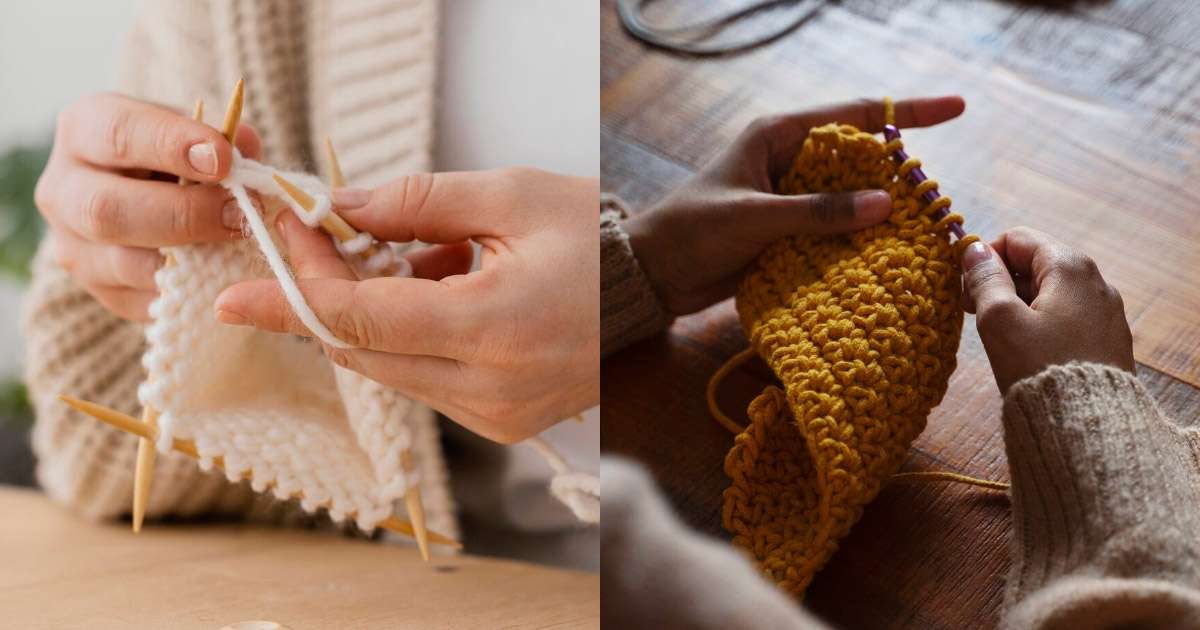Knit or Crochet? Choosing the Best Yarn Craft for Beginners

Everyone has different hobbies to relax and express creativity, and for those who love working with fabric and needles, knitting and crochet are two popular choices. These activities not only let you make beautiful, handmade items but also provide excellent mental health benefits.
In a study published in the British Journal of Occupational Therapy, approximately 81% of participants said they felt happier following the needlework session. These can help reduce anxiety, improve mood, and boost overall well-being. Engaging in these crafts gives a sense of achievement and mindfulness that many find deeply satisfying. If you’re interested in gaining these benefits, learning knitting or crochet could be a great hobby for you. But which one should you choose? Let’s explore both to help you decide.
What is Knitting?
Knitting uses two needles to make loops of yarn that connect to form fabric. There are different types of needles, such as straight, circular, and double-pointed, each for specific stitch styles and projects.
Popular knitting techniques include English knitting and German/Continental knitting. Knitted fabric has “V”-shaped stitches, making it great for smooth items like sweaters, scarves, and socks. The process involves moving stitches from one needle to the next, requiring dexterity and precision.
What is Crocheting?
Crocheting uses a single hook to pull loops of yarn through previous loops, creating stitches like single, double, and treble crochet. This method produces a thicker, more textured fabric compared to knitting.
Crochet stitches are made by piercing through earlier rows, resulting in a fabric that often looks like a chain of knots. Since it only requires one tool, crocheting is often easier for beginners to start. It’s versatile and can be used to make a variety of items, including toys, home decor, and intricate lace designs.
Similarities Between Knitting and Crocheting
Knitting and crocheting share several similarities:
- Material: Both use yarn.
- Creativity: Both allow for unique patterns and designs.
- Relaxation: Both offer meditative benefits, helping to reduce stress.
- Versatility: Both can produce a wide range of items, from clothing to home decor.
While they share these common traits, knitting and crocheting each have distinct characteristics that set them apart.
Differences Between Knitting and Crocheting
Tools and Techniques
Knitting uses two needles, which can be straight, circular, or double-pointed. This allows for detailed patterns and different fabric textures. However, it needs more dexterity and can be tricky to handle multiple tools, especially for beginners. The technique involves moving loops (stitches) from one needle to another, creating smooth and even fabrics perfect for clothing. But, fixing mistakes in knitting can be hard and takes time.
In crocheting, only a single hook is used, making it easier to manage, especially for beginners. While it might not be as precise for some detailed patterns, it’s easier to fix mistakes by unravelling stitches. The method involves creating loops directly on the fabric, leading to a denser and less stretchy material compared to knitting.
Fabric Texture
Knitting creates smooth, stretchy fabrics with “V”-shaped stitches, which are great for clothes and accessories needing a soft, flexible texture. These items often look polished and refined. However, knitting can take longer for large projects, and the smooth texture may not be ideal for items needing more structure.
Crocheting results in thicker, more textured fabrics that look like a series of knots. This makes it perfect for sturdy items like toys, baskets, and home decor. The texture adds visual interest but may not be as suitable for garments needing a lot of stretch or drape. Additionally, the thicker fabric can be heavier and warmer.
Project Speed
Knitting usually starts slower, especially for beginners learning the techniques. But once you get the hang of it, knitting can produce very detailed and high-quality items, with the slower pace helping to create intricate designs. The downside is that beginning projects may take longer, which can be discouraging.
Crocheting starts faster because the stitches are larger, making initial projects quicker. Quick results can be motivating and encourage further practice. This makes crochet ideal for fast projects. However, larger stitches use more yarn, making it less economical, and the quick pace may result in less detailed work compared to knitting.
Mistake Correction
In knitting, fixing errors can be more complex and time-consuming. Experienced knitters can find ways to fix mistakes without starting over, but beginners might find it frustrating to correct errors. Precision is needed for mistake correction.
Crocheting makes it easier to undo mistakes simply by unraveling stitches. This makes it beginner-friendly and less intimidating when correcting errors, allowing for quick adjustments without much disruption to the project. However, complex projects still need careful work to avoid mistakes, and frequent unraveling can wear out the yarn.
Cost and Tools
Knitting tends to be more expensive due to the need for various types of needles and extra tools like stitch markers and cable needles. Investing in quality tools can provide better results and more advanced projects, with interchangeable needle sets offering good value. But, the initial setup can be costly and overwhelming for beginners.
Crocheting is more cost-effective for beginners since it requires fewer tools. A single set of crochet hooks can handle most projects, making the initial costs lower and the experience simpler. However, crochet uses more yarn, increasing long-term costs, and some specialized projects may still need extra tools.
Choosing Between Knitting and Crocheting
Deciding between knitting and crocheting depends on what you like, what you want to make, and factors like time and budget. Here’s a simple guide to help you choose:
Personal Preferences
If you enjoy using both hands, try knitting. If you prefer using one hand, go for crocheting. Knitting is harder to learn but offers more complex designs. Crocheting is easier for beginners and gives quicker results.
Project Goals
Think about what you want to make. Knitting is great for clothes like sweaters and socks because it makes stretchy fabric. Crocheting is perfect for sturdy items like toys and baskets because it makes thicker fabric. For detailed patterns, knitting is better. Crocheting is good for simpler projects but can also handle detailed designs with practice.
Time and Budget
If you want quick projects, crocheting is faster. Knitting takes more time but can be more detailed. Crocheting needs fewer tools, making it cheaper to start but uses more yarn. Knitting needs more tools to start but uses less yarn.
Handling Mistakes
Crocheting is easier if you make mistakes since you can quickly undo stitches. Knitting mistakes are harder to fix and require more patience.
Relaxation and Enjoyment
Both crafts are relaxing, but knitting might be more calming for some because of its repetitive nature. Crocheting can also be soothing because it’s simple.
Resources and Community
There are many online tutorials and videos for both knitting and crocheting. You might also find local groups or classes to join.
In summary, choose the craft that matches your interests, the type of projects you want to create, and your available time and budget. Both knitting and crocheting have their own benefits, so you could even try both to see which one you enjoy more!

